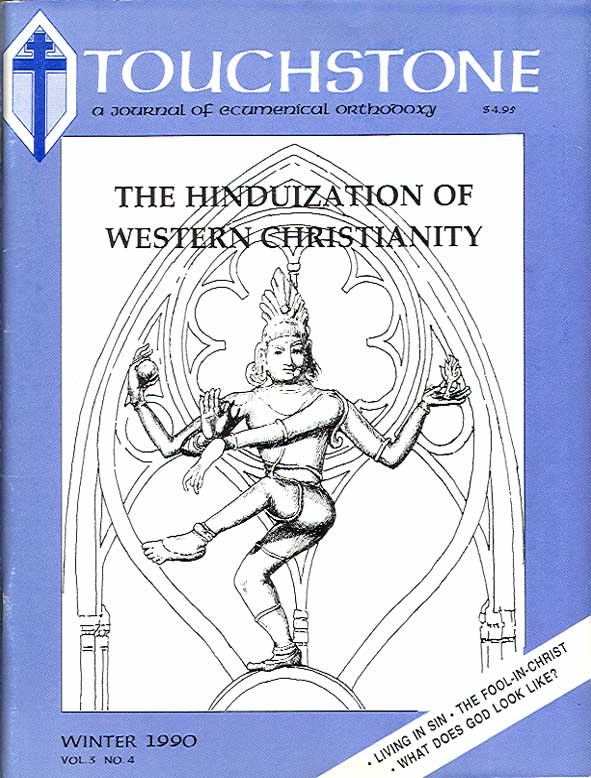Imaging God
by Patrick Henry Reardon
About a decade ago I had the opportunity to sit in on an interesting session of a conference on Christian Education being conducted in Evergreen, Colorado. The conference I recall was an annual affair back then, well attended by Christian educators from around the country, both diocesan personnel and parochial Sunday School people, of both sexes and all ages.
Well, in the particular session that I attended, the task assigned to the participants was that of drawing a picture of God. Crayons, chalks, felt tip markers and sundry similar implements were apportioned to the assembly, along with generous sheets of newsprint, and for some thirty minutes the group proceeded to make unto itself the likeness of things in heaven and on earth and under the earth, though not going quite so far as to bow down unto them nor to worship them. Not being a true participant, I was permitted to sit quietly while the great exercise was in process.
At the end of a half-hour or so, each of the participants in the experiment was in turn called to the front of the hall to display his or her picture of God and to explain the image to the rest of us. Most of the efforts were very abstract, with lots of angled and radiant lines, circles, various geometric shapes and designs. The colors were largely pastel. Only one of the pictures, I remember, conveyed something alive. Well, almost alive; it was a small, cut rose, entirely black. The craftsman of this portrait was a young priest, a diocesan director of Christian education, who kept referring to his little, black, divine flower as “she.” Hoping to receive Holy Communion the next day without first going to Confession, I resisted the urge to comment.
Well, the whole experience I found bewildering, let me say, and I left Evergreen somewhat jarred and disoriented. I knew those folks were all regular reciters of the Nicene Creed, sharers in the same Sacraments that nourished me, but it seemed that they worshipped a different divinity than I. At this I was less offended than stunned; the experience was more paralyzing than painful. My sensation, or lack of it, would have been much the same if I were suddenly to learn that my wife, whom I fancied to be the very soul of virtue and modesty, was really a pirate’s paramour or the secret convener of a coven. For months I staggered around muttering that I did not want my kids getting their Christian education from any flower-worshipper.
The memory of that event comes back to me now and then, particularly when I read feminist theology and that sort of thing. Recently I thought of it again when a friend showed me an article in the October 22, 1989 issue of The Living Church, a denominational weekly. Written by the Reverend David Holsinger, a clergyman from Honolulu, the piece was called “Struggling to Imagine God.” Actually, I am indebted to the author, for he spoke more truly and reprensentatively of the drift in modern American theology than perhaps he knew, and his article helped to focus thoughts and reactions which have been for some time coming together in my mind.
The thesis of the article was straightforward enough: “We have not yet discovered who God is, and never will in this life. But if we could, God would be neither woman nor man, of that you can be sure. The words man and woman, father or mother, are simply terms to help imagine the unimaginable, to explain the unexplainable, and to try to define the undefinable.” After thus identifying the hopeless job of talking adequately about God, Mr. Holsinger proceeded to argue that masculine and feminine language descriptive of God are of pretty much equal value, both suggesting certain points of analogy that are somewhat useful. In closing he asked us to “thank God for inclusive language, that it will help us to bring about a fuller and more adequate understanding of what we mean when we make reference to the Divine Reality, for some, ‘God our Father’, and for others, ‘God our Mother’.”
I commend Mr. Holsinger for speaking of the Divine Reality beyond all words. Indeed let us insist on the point. “The act of the believer,” wrote Thomas Aquinas, “does not terminate at a proposition (enuntiabile) but at the very Reality (ipsam Rem)” (Summa Theologica II II 1.2.ad2). Mr. Holsinger is apparently no theologian of the mirror, no disciple of Feuerbach, who taught that the divine is only a reflection of the human; nor does he, like Freud, attempt to “transform metaphysics into metapsychology.” He happily professes a God quite distinct from our concepts and imaginings about God.
On three critical points, however, I take issue with Mr. Holsinger. And I believe these points are very cogent to a far greater argument being advanced in our day—a dangerous drift in contemporary theology.
First, in asserting that the names of God “are simply terms,” our Hawaiian clergyman is plainly enunciating the classical thesis of nominalism, for neither Roscellinus nor Ockham would have put the matter differently. Now let me say that I am among those today burdened with the suspicion that a deeply embedded nominalism is at the root of the present Trinitarian and christological crises of Western Christianity.
To me nominalism seems to be only another example of that Western subjectivity of which Eastern theologians are always complaining. Nominalism is a mental prison, allowing the mind to apprehend only its own terms, not the ontological realities beyond those terms, and contemporary experience is showing that it is open to all manner of manipulation. To root all of Creation and Redemption in the sovereign divine will, apart from and metaphysically independent of the divine wisdom, has in our times seemed to evoke a like willfulness and caprice from those who hold such a view.
Patrick Henry Reardon is pastor emeritus of All Saints Antiochian Orthodox Church in Chicago, Illinois, and the author of numerous books, including, most recently, Out of Step with God: Orthodox Christian Reflections on the Book of Numbers (Ancient Faith Publishing, 2019).
subscription options
Order
Print/Online Subscription

Get six issues (one year) of Touchstone PLUS full online access including pdf downloads for only $39.95. That's only $3.34 per month!
Order
Online Only
Subscription

Get a one-year full-access subscription to the Touchstone online archives for only $19.95. That's only $1.66 per month!
bulk subscriptions
Order Touchstone subscriptions in bulk and save $10 per sub! Each subscription includes 6 issues of Touchstone plus full online access to touchstonemag.com—including archives, videos, and pdf downloads of recent issues for only $29.95 each! Great for churches or study groups.
Transactions will be processed on a secure server.
more from the online archives
calling all readers
Please Donate
"There are magazines worth reading but few worth saving . . . Touchstone is just such a magazine."
—Alice von Hildebrand
"Here we do not concede one square millimeter of territory to falsehood, folly, contemporary sentimentality, or fashion. We speak the truth, and let God be our judge. . . . Touchstone is the one committedly Christian conservative journal."
—Anthony Esolen, Touchstone senior editor









